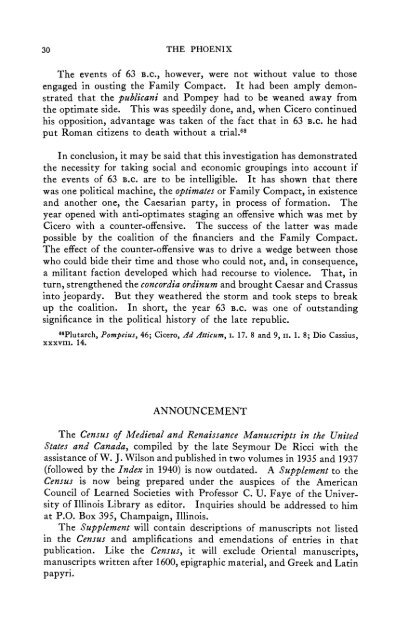Catiline and the "Concordia Ordinum" - Historia Antigua
Catiline and the "Concordia Ordinum" - Historia Antigua
Catiline and the "Concordia Ordinum" - Historia Antigua
Create successful ePaper yourself
Turn your PDF publications into a flip-book with our unique Google optimized e-Paper software.
30 THE PHOENIX<br />
The events of 63 B.C., however, were not without value to those<br />
engaged in ousting <strong>the</strong> Family Compact. It had been amply demonstrated<br />
that <strong>the</strong> publicani <strong>and</strong> Pompey had to be weaned away from<br />
<strong>the</strong> optimate side. This was speedily done, <strong>and</strong>, when Cicero continued<br />
his opposition, advantage was taken of <strong>the</strong> fact that in 63 B.C. he had<br />
put Roman citizens to death without a trial.68<br />
In conclusion, it may be said that this investigation has demonstrated<br />
<strong>the</strong> necessity for taking social <strong>and</strong> economic groupings into account if<br />
<strong>the</strong> events of 63 B.C. are to be intelligible. It has shown that <strong>the</strong>re<br />
was one political machine, <strong>the</strong> optimates or Family Compact, in existence<br />
<strong>and</strong> ano<strong>the</strong>r one, <strong>the</strong> Caesarian party, in process of formation. The<br />
year opened with anti-optimates staging an offensive which was met by<br />
Cicero with a counter-offensive. The success of <strong>the</strong> latter was made<br />
possible by <strong>the</strong> coalition of <strong>the</strong> financiers <strong>and</strong> <strong>the</strong> Family Compact.<br />
The effect of <strong>the</strong> counter-offensive was to drive a wedge between those<br />
who could bide <strong>the</strong>ir time <strong>and</strong> those who could not, <strong>and</strong>, in consequence,<br />
a militant faction developed which had recourse to violence. That, in<br />
turn, streng<strong>the</strong>ned <strong>the</strong> concordia ordinum <strong>and</strong> brought Caesar <strong>and</strong> Crassus<br />
into jeopardy. But <strong>the</strong>y wea<strong>the</strong>red <strong>the</strong> storm <strong>and</strong> took steps to break<br />
up <strong>the</strong> coalition. In short, <strong>the</strong> year 63 B.C. was one of outst<strong>and</strong>ing<br />
significance in <strong>the</strong> political history of <strong>the</strong> late republic.<br />
6sPlutarch, Pompeius, 46; Cicero, Ad Atticum, I. 17. 8 <strong>and</strong> 9, 11. 1. 8; Dio Cassius,<br />
xxxviii. 14.<br />
ANNOUNCEMENT<br />
The Census of Medieval <strong>and</strong> Renaissance Manuscripts in <strong>the</strong> United<br />
States <strong>and</strong> Canada, compiled by <strong>the</strong> late Seymour De Ricci with <strong>the</strong><br />
assistance of W. J. Wilson <strong>and</strong> published in two volumes in 1935 <strong>and</strong> 1937<br />
(followed by <strong>the</strong> Index in 1940) is now outdated. A Supplement to <strong>the</strong><br />
Census is now being prepared under <strong>the</strong> auspices of <strong>the</strong> American<br />
Council of Learned Societies with Professor C. U. Faye of <strong>the</strong> University<br />
of Illinois Library as editor. Inquiries should be addressed to him<br />
at P.O. Box 395, Champaign, Illinois.<br />
The Supplement will contain descriptions of manuscripts not listed<br />
in <strong>the</strong> Census <strong>and</strong> amplifications <strong>and</strong> emendations of entries in that<br />
publication. Like <strong>the</strong> Census, it will exclude Oriental manuscripts,<br />
manuscripts written after 1600, epigraphic material, <strong>and</strong> Greek <strong>and</strong> Latin<br />
papyri.

















